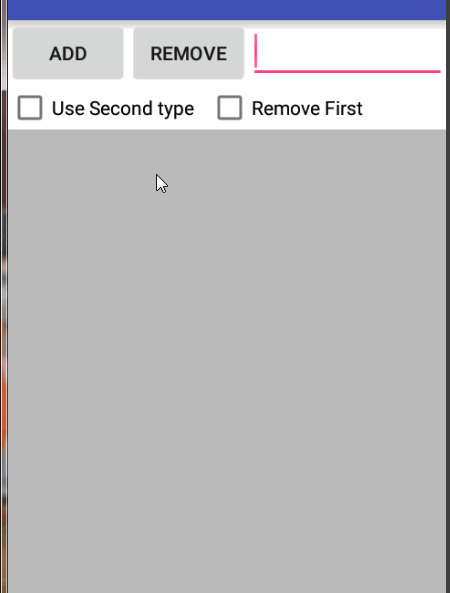这个标签的布局唯一的难点也就是布局和测量而已。
我们只需要重写ViewGroup里面两个方法即可!
protected void onMeasure(int widthMeasureSpec, int heightMeasureSpec)
@Override
protected void onMeasure(int widthMeasureSpec, int heightMeasureSpec) {
super.onMeasure(widthMeasureSpec, heightMeasureSpec);
measureChildren(widthMeasureSpec, heightMeasureSpec);
int hMode = MeasureSpec.getMode(heightMeasureSpec);
int height = 0;
if (hMode == MeasureSpec.EXACTLY){
height = MeasureSpec.getSize(heightMeasureSpec);
}else {
int width = MeasureSpec.getSize(widthMeasureSpec);
int count = getChildCount();
int lineWidth = width;
int maxHeight = 0;
for (int i = 0; i < count ; i++) {
View childView = getChildAt(i);
int childWidth = childView.getMeasuredWidth();
int childHeight = childView.getMeasuredHeight();
if (childHeight > maxHeight){
maxHeight = childHeight;
}
if (height < maxHeight ){
height = maxHeight + 2*linePadding;
}
if (lineWidth > childWidth + eachPadding){
lineWidth -= (childWidth + eachPadding);
}else {
lineWidth = (width - childWidth + eachPadding);
height += maxHeight+linePadding;
}
}
}
setMeasuredDimension(MeasureSpec.getSize(widthMeasureSpec),height);
}关于控件的长宽属性match、wrap啥的,在这篇里面有过介绍了(http://blog.csdn.net/ocwvar/article/details/50682213)这里就不重复说了。
控件的宽度默认为父容器的宽度。咱们这里要确定的就是ViewGroup的高度,依次计算 每一行所能容下多少个Item+每个Item的间隔,不够的时候就将高度区域增加 累积高度+每行间隔+上一行最高Item的高度 。直到所有Item计算完毕。
protected void onLayout(boolean changed, int l, int t, int r, int b)
@Override
protected void onLayout(boolean changed, int l, int t, int r, int b) {
int count = getChildCount();
int lastLeft = getPaddingLeft() + eachPadding;
int lastTop = linePadding;
int restWidth = getMeasuredWidth();
int maxHeight = 0;
for (int i = 0; i < count; i++) {
View childView = getChildAt(i);
int width = childView.getMeasuredWidth();
int height = childView.getMeasuredHeight();
if (restWidth > width + eachPadding){
childView.layout( lastLeft+=eachPadding , lastTop , lastLeft+=width , lastTop+height);
}else {
restWidth = r;
lastLeft = l + eachPadding;
lastTop += (linePadding + maxHeight);
childView.layout( lastLeft+=eachPadding , lastTop ,lastLeft+=width, lastTop+height);
}
if (height > maxHeight){
maxHeight = height;
}
restWidth -= width + eachPadding;
}
}在绘制的时候和测量高度也是差不多的,咱们要首先记下刚开始时的X,Y。然后依次绘制 间隔+Item+间隔+Item+间隔 直到剩余长度(restWidth)不够,咱们就移到下一行的位置(上一行的Y+上一行最高Item的高度+每行的间隔)。
剩下的就是Tag的添加与移除的处理,咱们的Tag有两种风格,对应着的也就是两种布局而已。
public void addTag(String tag, int position,boolean isSecondStyle)
public void addTag(String tag, int position,boolean isSecondStyle){
final View tagView;
TextView textView;
int count = getChildCount();
if (position > count){
position = count;
}else if (position < 0 ){
position = 0;
}
if (isSecondStyle){
tagView = LayoutInflater.from(getContext()).inflate(secondViewLayout,this,false);
textView = (TextView)tagView.findViewById(secondTVID);
}
else{
tagView = LayoutInflater.from(getContext()).inflate(tagViewLayout,this,false);
textView = (TextView)tagView.findViewById(firstTVID);
}
tagView.setOnClickListener(new OnClickListener() {
@Override
public void onClick(View v) {
if (onTagClick != null){
onTagClick.onTagClick(v.getTag().toString(),indexOfChild(tagView));
}
}
});
if (tag.length() > 12){
tag = String.valueOf(tag.toCharArray(),0,TAG_MAX_LENGTH)+"...";
}
tagView.setTag(tag);
textView.setSingleLine(true);
textView.setText(tag);
addView(tagView, position);
requestLayout();
measureChildren(getMeasuredWidth(), getMeasuredHeight());
}唯一要注意的一个地方就是
String.valueOf(tag.toCharArray(),0,TAG_MAX_LENGTH)+”…”;
当Tag的文本太长的时候非常有碍观瞻,我们可以将其缩减,就像示例图里面那样,比如将:asdfghjkl 缩减成 asdfgh… 这样的固定长度即可。
移除Tag的方法:
public void removeTag(String tagText,boolean onlyRemoveFirstFind)
public void removeTag(String tagText,boolean onlyRemoveFirstFind){
List<Integer> tags = null;
if (!onlyRemoveFirstFind){
tags = new ArrayList<>();
}
if (tagText.length() > TAG_MAX_LENGTH){
tagText = String.valueOf(tagText.toCharArray(),0,TAG_MAX_LENGTH)+"...";
}
int count = getChildCount();
for (int i = 0; i < count; i++) {
View childView = getChildAt(i);
if (childView != null && childView.getTag() != null && childView.getTag().equals(tagText)){
if (!onlyRemoveFirstFind){
tags.add(0,i);
}else {
removeViewAt(i);
break;
}
}
}
if (!onlyRemoveFirstFind){
for (int i = 0; i < tags.size(); i++) {
removeViewAt(tags.get(i));
}
}
requestLayout();
}这也没啥好讲的。。






















 371
371











 被折叠的 条评论
为什么被折叠?
被折叠的 条评论
为什么被折叠?








